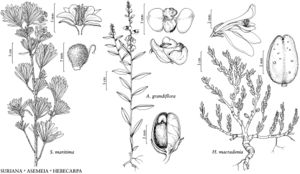Suriana maritima
Sp. Pl. 1: 284. 1753.
Shrubs 0.7–3 (–8) m, sometimes trees in sheltered sites, densely branched. Leaves 10–40 × 1–5 (–7) mm. Inflorescences 1–23-flowered. Flowers: calyx 6–10 mm; petals ± 4 mm. Fruits 4–6 mm diam.
Phenology: Flowering year-round.
Habitat: Sandy and coral-rock ocean shores, from just above high-water line to low dunes and hammocks.
Elevation: 0–10 m.
Distribution
Fla., Mexico, West Indies, Central America, n South America, se Asia, e Africa, Indian Ocean Islands, Pacific Islands, n Australia
Discussion
Although Suriana maritima is widely distributed in the tropics, in the flora area it is native only to coastal Florida, west to the Dry Tortugas and north to Brevard and Pinellas counties, where much of its habitat has been eliminated by development.
A proportionately large air space within the drupelets enables them to float for long periods, thereby being dispersed by ocean currents. Because of its tolerance of salt and resistance to wind, Suriana maritima is valued as a landscape plant and for erosion control. In some parts of its range, the wood has a limited use for making small articles. Preparations from the leaves and bark have been used for medicinal purposes, including the treatment of fevers and intestinal problems (D. W. Nellis 1994).
Selected References
None.
